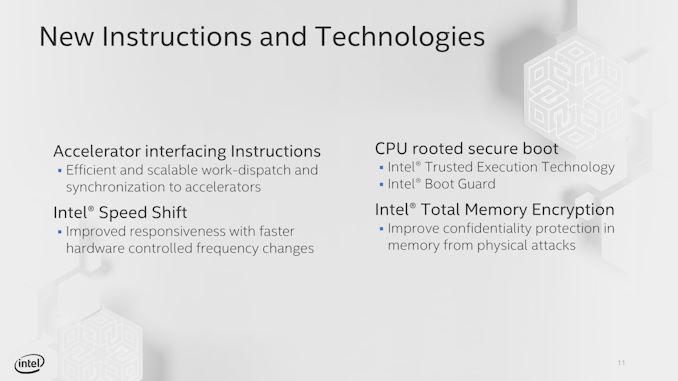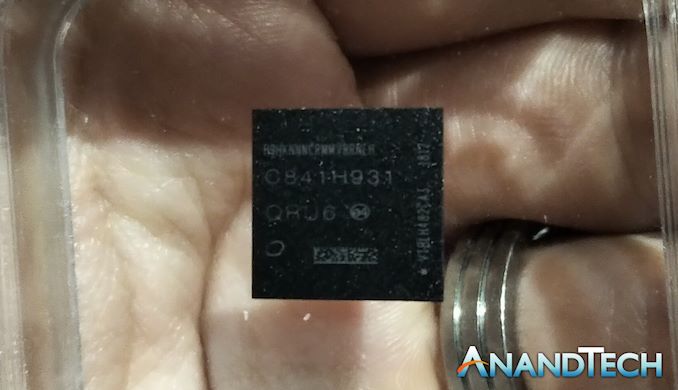Intel's new Atom Microarchitecture: The Tremont Core in Lakefield
by Dr. Ian Cutress on October 24, 2019 1:30 PM ESTBeyond the Core
Nominally today’s disclosure is more about the Tremont microarchitecture than any SoC it might appear in, like Lakefield or Snow Ridge. To that end, Intel wasn’t talking about GPU support (Lakefield will have Gen11 graphics), but Intel did discuss that Tremont would be the first Atom design to fully support Intel’s Speed Shift / ACPI hardware flags, allowing for faster ramp-up and ramp-down of high-frequency operation.
Intel also stated that Tremont supports Total Memory Encryption to prevent physical attacks, Rooted Secure Boot and Boot Guard, and specific accelerator interfacing instructions. With respect to Spectre, Meltdown, and L1TF, Intel stated that Tremont will have the same protections as Cascade Lake.
We also asked Intel about module-level voltage and power control. We were told that within a quad-core module with four Tremont cores, all the cores share the same frequency plane, but each core can enter separate c-states to reduce power consumption when not in use.
Final Thoughts and Slide Deck
In the past, at least from my perspective, dealing with Atom platforms has been amusing. Atom devices typically work great for hyper-focused and optimized software that can take advantage of a latency-insensitive workload, such as networking equipment or a NAS, but for any general purpose use I find them incredibly slow. Perhaps I’m just too used to the big cores on the devices I use – but with Intel saying that Atom is being refocused on performance, it will be interesting to see how Tremont devices and other Core devices will overlap. This graph from Intel is very striking, and if you squint, it looks a lot like some of the smartphone power/performance graphs we’ve produced in the past.
With Intel moving Core down in power to the 1.5W level, again it will be interesting to see how Tremont can play in that 2mW to 2W range that Atom has traditionally played in. The last generation Goldmont Plus devices were going beyond that, and in this power range we also have smartphone cores coming into play. After showing the slide deck to Andrei, we were discussing how a Tremont might stack up against an Arm Cortex A76, or a Kryo core. When we can get our hands on Tremont, we’ll see how they compare. When it comes to the products that Tremont is aiming for however, it still has that x86 advantage.
We did ask a few questions from Intel that we didn’t get answers to, such as die size and target frequencies. The other question to discuss is Intel’s current high-demand issues putting pressure on its manufacturing technologies. Tremont is still a low cost, low powered core, so logic may dictate that it will be a while before we see consumer chips enter the market. Ultimately Intel’s high-demand issues are around 14nm, and so far we’ve only seen Tremont discussed on Intel’s 10+ process with Lakefield and Snow Ridge. What we know about Intel’s 10nm/10+ capacity isn’t a lot, but reports vary from yields being ‘on track’ to ‘working with key OEM partners only’. Intel’s driver for 10+ right now is Ice Lake, which is coming to some premium notebook designs this year, and Lakefield has been announced for the Surface Neo. It is not known what the expected volume for the Neo will be, but it is unlikely to be large. Whether or not Tremont will see the light of day in traditional Atom Celeron and Pentium processors is another question entirely – the Goldmont Atom families have suffered while Intel’s 14nm efforts are more focused on enterprise hardware that can be sold for a much higher $$ per square millimeter. Beyond Lakefield, we might not actually see Tremont in any other consumer chip before the next generation Atom if Intel cannot get its issues sorted.
As and when we get a Lakefield device, we will put it through our tests. Stay tuned.













101 Comments
View All Comments
29a - Friday, October 25, 2019 - link
Interesting that you say that because I had to install Plex on my desktop the other day because the Atom in my NAS couldn't decode the video. My other experience with an Atom was when I bought a netbook right before tablets became popular. That netbook couldn't stream a video from Youtube without studdering. Both of my experiences with Atoms have been absolutely horrible,eddman - Friday, October 25, 2019 - link
You expect a J1900 from 2013 to decode every single type of video? That processor's decoder cannot hardware accelerate VP9 and HEVC. It also cannot accelerate 10-bit h.264 (there is no hardware decoder that can).If it fails even for regular h.264, then the problem is somewhere else, not the processor.
eddman - Friday, October 25, 2019 - link
It seems it can accelerate HEVC after all, but I don't know if it's full hardware acceleration or hybrid. If the latter, then it'll struggle with high bit-rate videos.There is definitely no 10-bit support though.
eddman - Friday, October 25, 2019 - link
Scratch that; no HEVC for Bay Trail: https://www.anandtech.com/show/9167/intel-compute-...digitalgriffin - Thursday, October 24, 2019 - link
Lol. Hey Randy. Hows the layout going? Small world.PeachNCream - Friday, October 25, 2019 - link
When it comes to gaming on Windows, Bay Trail runs everything I ask it to run. Picking the right games for the system obviously is necessary. The first and second Star Wars Battlefront, Terraria, Age of Wonders, and a smattering of other fairly old titles that are on the low end of demand run fine at max settings (minus AA, of course). In Atom's single core days, the old N270 and N450 were sufficient as my primary Windows gaming laptops as well when they were in little netbooks. Pick your games wisely, go have fun. You still have to do that even with relatively modern hardware and recent titles so I don't see the difference in working with a little less and lowering your overall hardware (and often software) cost because you were still entertained for a few hours when its all said and done.mkozakewich - Sunday, October 27, 2019 - link
I was playing Minecraft on the N270. Good times! The newer Intel chips focus more on lowering the power usage than on increasing performance, although Bay Trail was still pretty good. (I'm writing this on a Surface Book with a Core i7, and the whole system is running on less wattage than even my 2011 netbook.)Jorgp2 - Thursday, October 24, 2019 - link
Yeah, like 4 years ago.Get with the times
digitalgriffin - Thursday, October 24, 2019 - link
Gimini lake can transcode 4 1080p streams at a time for plex. And it will do 4k video no problem. But it lacks hdr support. If intel solves this problem then you jave a great little media serverIII-V - Thursday, October 24, 2019 - link
Over half a decade ago... where have you been?